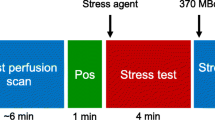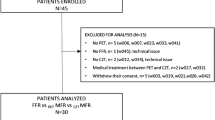Abstract
Background
Ejection fraction (EF) reserve has been found to be a useful adjunct for identifying high risk coronary artery disease in cardiac positron emission tomography (PET). We aimed to evaluate EF reserve obtained from technetium-99m sestamibi (Tc-99m) high-efficiency (HE) SPECT.
Methods
Fifty patients (mean age 69 years) undergoing regadenoson same-day rest (8-11 mCi)/stress (32-42 mCi) Tc-99m gated HE SPECT were enrolled. Stress imaging was started 1 minute after sequential intravenous regadenoson .4 mg and Tc-99m injections, and was composed of five 2 minutes supine gated acquisitions followed by two 4 minutes supine and upright images. Ischemic total perfusion deficit (ITPD) ≥5 % was considered as significant ischemia.
Results
Significantly lower mean EF reserve was obtained in the 5th and 9th minute after regadenoson bolus in patients with significant ischemia vs patients without (5th minute: −4.2 ± 4.6% vs 1.3 ± 6.6%, P = .006; 9th minute: −2.7 ± 4.8% vs 2.0 ± 6.6%, P = .03).
Conclusions
Negative EF reserve obtained between 5th and 9th minutes of regadenoson stress demonstrated best concordance with significant ischemia and may be a promising tool for detection of transient ischemic functional changes with Tc-99m HE-SPECT.
Spanish Abstract
Antecedentes
Se ha encontrado que la reserva de la Fracción de Eyección (FE) en la tomografía de emisión de positrones cardiaca (PET, positron emission tomography por sus siglas en ingles) es una herramienta útil adicional en la identificación de pacientes con enfermedad arterial coronaria de alto riesgo. Nuestro objetivo fue evaluar la reserva de la FE obtenida por SPECT de alta eficiencia (AE) con Tecnecio-99m (Tc-99m) sestamibi.
Métodos
Cincuenta pacientes (edad promedio 69 años) a quienes se les realizo un SPECT de AE con Tc‐99m sincronizado con el electrocardiograma en un solo día reposo (8-11mCi)/estrés 32-42mCi) con regadenoson fueron incluidos La adquisición de las imágenes de estrés se inicio un minuto después de la administración secuencial intravenosa de regadenoson .4mg y Tc-99m, compuesta de 5 adquisiciones sincronizadas con el electrocardiograma de 2 minutos cada una en supino seguidas de dos adquisiciones de 4 minutos cada una en supino y sentado. Un defecto total de perfusión isquémico (DTPI) ≥5% fue considerado como isquemia significativa.
Resultados
El promedio obtenido de la Reserva de la FE fue significativamente menor en los minutos 5to y 9no posterior al bolo de regadenoson en pacientes con isquemia significativa comparados con pacientes sin isquemia (5to minuto: −4.2 ± 4.6% vs 1.3 ± 6.6%, p= 0.006; 9no minuto: −2.7 ± 4.8% vs 2.0 ± 6.6%, p = 0.03).
Conclusiones
Una Reserva de la FE negativa obtenida en los minutos 5to y 9no del estrés con regadenoson demostró una mejor concordancia con la presencia de isquemia significativa y podría ser un herramienta promisoria para la detección de cambios funcionales isquémicos transitorios con un estudio SPECT de AE con Tc-99m.
Chinese Abstract
背景
对于心脏PET显像, 射血分数 (EF) 储备 已成为评判高风险冠心病的有效辅助手段。本文旨在评价采用Tc-99m甲氧基异丁基异睛显影剂和高能SPECT测定EF储备的可行性。
方法
入选55行类伽腺苷一日法静息 (8-11mCi) /负荷 (32-42mCi) 门控高能SPECT显像的患者, 平均年龄为69岁。在连续静脉注射类伽腺苷 (0.4mg) 和Tc-99m一分钟后开始负荷图像的采集。负荷图像包括5个2分钟的仰卧位门控采集和后续2个分别为仰卧位和直立位的4分钟门控采集。总灌注缺损≧5%为显著缺血。
结果
注射类伽腺苷后, 显著缺血患者的平均EF储备在第5和第9分钟时较无缺血患者显著降低 (第5分钟: −4.2 ± 4.6% vs. 1.3 ± 6.6%, p = 0.006; 第9分钟: −2.7 ± 4.8% vs. 2.0 ± 6.6%, p=0.03)。
结论
在类伽腺苷负荷时, 第5至9分钟测得的EF储备负值与显著缺血的一致性最佳, 这很可能成为Tc-99m高能SPECT检测一过性心肌缺血伴随的心功能改变的有效手段。






Similar content being viewed by others
Abbreviations
- SPECT:
-
Single-photon emission computed tomography
- MPI:
-
Myocardial perfusion imaging
- CAD:
-
Coronary artery disease
- LV:
-
Left ventricular
- EF:
-
Ejection fraction
- PET:
-
Positron emission tomography
- HE:
-
High-efficiency
- CZT:
-
Cadmium-zinc-telluride
- TPD:
-
Total perfusion deficit
- ITPD:
-
Ischemic total perfusion deficit
- SD:
-
Standard deviation
References
Holly TA, Abbott BG, Al-Mallah M, Calnon DA, Cohen MC, DiFilippo FP, et al. Single photon-emission computed tomography. J Nucl Cardiol 2010;5:941-73.
Berman DS, Kang X, Slomka PJ, Gerlach J, de Yang L, Hayes SW, et al. Underestimation of extent of ischemia by gated SPECT myocardial perfusion imaging in patients with left main coronary artery disease. J Nucl Cardiol 2007;4:521-8.
Lima RS, Watson DD, Goode AR, Siadaty MS, Ragosta M, Beller GA, Samady H. Incremental value of combined perfusion and function over perfusion alone by gated SPECT myocardial perfusion imaging for detection of severe three-vessel coronary artery disease. J Am Coll Cardiol 2003;1:64-70.
Sharir T, Germano G, Kavanagh PB, Lai S, Cohen I, Lewin HC, et al. Incremental prognostic value of post-stress left ventricular ejection fraction and volume by gated myocardial perfusion single photon emission computed tomography. Circulation 1999;10:1035-42.
Sharir T, Bacher-Stier C, Dhar S, Lewin HC, Miranda R, Friedman JD, et al. Identification of severe and extensive coronary artery disease by postexercise regional wall motion abnormalities in Tc-99m sestamibi gated single-photon emission computed tomography. Am J Cardiol 2000;11:1171-5.
Abidov A, Bax JJ, Hayes SW, Cohen I, Nishina H, Yoda S, et al. Integration of automatically measured transient ischemic dilation ratio into interpretation of adenosine stress myocardial perfusion SPECT for detection of severe and extensive CAD. J Nucl Med 2004;12:1999-2007.
Dorbala S, Vangala D, Sampson U, Limaye A, Kwong R, Di Carli MF. Value of vasodilator left ventricular ejection fraction reserve in evaluating the magnitude of myocardium at risk and the extent of angiographic coronary artery disease: an 82Rb PET/CT study. J Nucl Med 2007;3:349-58.
Imbert L, Poussier S, Franken PR, Songy B, Verger A, Morel O, et al. Compared performance of high-sensitivity cameras dedicated to myocardial perfusion SPECT: A comprehensive analysis of phantom and human images. J Nucl Med 2012;12:1897-903.
Sharir T, Slomka PJ, Hayes SW, DiCarli MF, Ziffer JA, Martin WH, et al. Multicenter trial of high-speed vs conventional single-photon emission computed tomography imaging: Quantitative results of myocardial perfusion and left ventricular function. J Am Coll Cardiol 2010;18:1965-74.
Erlandsson K, Kacperski K, van Gramberg D, Hutton BF. Performance evaluation of D-SPECT: a novel SPECT system for nuclear cardiology. Phys Med Biol 2009;9:2635-49.
Iskandrian AE, Bateman TM, Belardinelli L, Blackburn B, Cerqueira MD, Hendel RC, et al. ADVANCE MPI Investigators. Adenosine vs regadenoson comparative evaluation in myocardial perfusion imaging: Results of the ADVANCE phase 3 multicenter international trials. J Nucl Cardiol 2007;5:645-58.
Sharir T, Ben-Haim S, Merzon K, Prochorov V, Dickman D, Ben-Haim S, Berman DS. High-speed myocardial perfusion imaging. Initial clinical comparison with conventional dual detector Anger camera imaging. J Am Coll Cardiol Imaging 2008;1:156-63.
Patton J, Berman DS, Slomka P. Recent technological advances in nuclear cardiology. J Nucl Cardiol 2007;14:433-54.
Slomka PJ, Nishina H, Berman DS, Akincioglu C, Abidov A, Friedman JD, et al. Automated quantification of myocardial perfusion SPECT using simplified normal limits. J Nucl Cardiol 2005;1:66-77.
Xu Y, Kavanagh P, Fish M, Gerlach J, Ramesh A, Lemley M, et al. Automated quality control for segmentation of myocardial perfusion SPECT. J Nucl Med 2009;9:1418-26.
Nishina H, Slomka PJ, Abidov A, Yoda S, Akincioglu C, Kang X, et al. Combined supine and prone quantitative myocardial perfusion SPECT: method development and clinical validation in patients with no known coronary artery disease. J Nucl Med 2006;1:51-8.
Berman DS, Kang X, Tamarappoo B, Wolak A, Hayes SW, Nakazato R, et al. Stress thallium-201/rest technetium-99m sequential dual isotope high-speed myocardial perfusion imaging. JACC Cardiovasc Imaging 2009;3:273-82.
Askew JW, Miller TD, Ruter RL, Jordan LG, Hodge DO, Gibbons RJ, O’Connor MK. Early image acquisition using a solid-state cardiac camera for fast myocardial perfusion imaging. J Nucl Cardiol 2011;5:840-6.
Nakazato R, Slomka PJ, Fish M, Schwartz RG, Hayes SW, Thomson LE, et al. Quantitative high-efficiency cadmium-zinc-telluride SPECT with dedicated parallel-hole collimation system in obese patients: Results of a multi-center study. J Nucl Cardiol 2014;2:266-75.
Hsiao E, Ali B, Blankstein R, Skali H, Ali T, Bruyere J Jr, et al. Detection of obstructive coronary artery disease using regadenoson stress and 82Rb PET/CT myocardial perfusion imaging. J Nucl Med 2013;10:1748-54.
Dorbala S, Hachamovitch R, Curillova Z, Thomas D, Vangala D, Kwong RY, Di Carli MF. Incremental prognostic value of gated Rb-82 positron emission tomography myocardial perfusion imaging over clinical variables and rest EF. JACC Cardiovasc Imaging 2009;7:846-54.
Slomka PJ, Berman DS, Germano G. New cardiac cameras: Single-photon emission CT and PET. Semin Nucl Med 2014;4:232-51.
Ben-Haim S, Murthy VL, Breault C, Allie R, Sitek A, Roth N, Fantony J, et al. Quantification of myocardial perfusion reserve using dynamic SPECT imaging in humans: A feasibility study. J Nucl Med 2013;6:873-9.
Acknowledgment
This research was supported in part by Grant R01HL089765 from the National Heart, Lung, and Blood Institute/National Institutes of Health (NHLBI/NIH) (PI: Piotr Slomka). Its contents are solely the responsibility of the authors and do not necessarily represent the official views of the NHLBI/NIH. Yafim Brodov, MD, PhD is a Michael Kogan Save a Heart Foundation fellow in Cardiac Imaging and Nuclear Cardiology, Cedars-Sinai Medical Center, Los Angeles, California.
Author information
Authors and Affiliations
Corresponding author
Ethics declarations
Disclosure
Drs Piotr Slomka, Guido Germano, and Daniel Berman receive royalties from the QPS software employed in the study for the quantification of perfusion. Dr Mathews Fish is a medical consultant for Spectrum Dynamics. All others disclose no current conflict of interest.
Additional information
JNC thanks Dr. E. Alexanderson, UNAM, Mexico, for providing the Spanish abstract, and Weihua Zhou, PhD, University of Southern Mississippi, USA, for providing the Chinese abstract. An audio interview between Dr. Slomka and the editor-in-chief, Dr. Iskandrian, discussing the article can be found as Electronic Supplementary Material at SpringerLink.
See related editorial, doi:10.1007/s12350-016-0570-8.
Electronic supplementary material
Below is the link to the electronic supplementary material.
Rights and permissions
About this article
Cite this article
Brodov, Y., Fish, M., Rubeaux, M. et al. Quantitation of left ventricular ejection fraction reserve from early gated regadenoson stress Tc-99m high-efficiency SPECT. J. Nucl. Cardiol. 23, 1251–1261 (2016). https://doi.org/10.1007/s12350-016-0519-y
Received:
Accepted:
Published:
Issue Date:
DOI: https://doi.org/10.1007/s12350-016-0519-y




